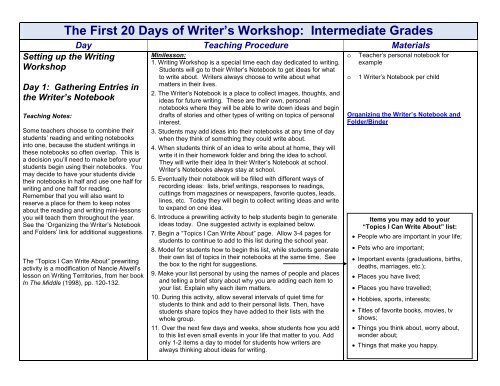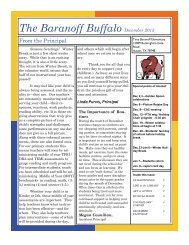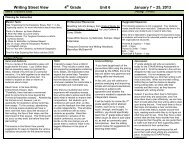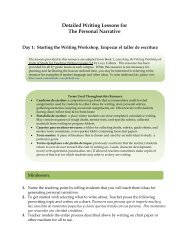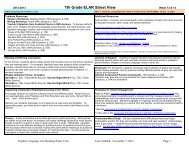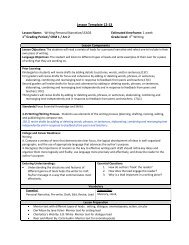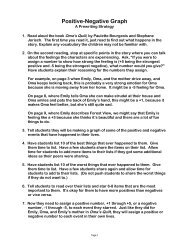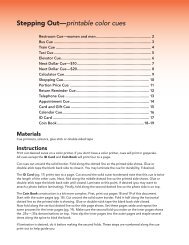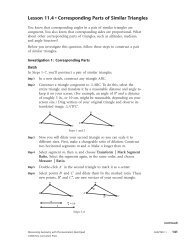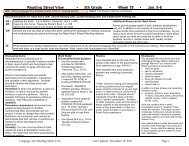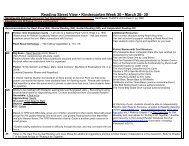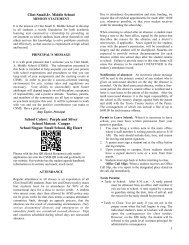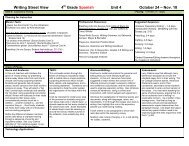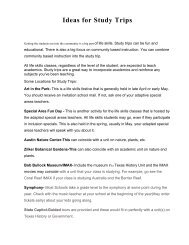The First 20 Days of Writer's Workshop: Intermediate Grades
The First 20 Days of Writer's Workshop: Intermediate Grades
The First 20 Days of Writer's Workshop: Intermediate Grades
- No tags were found...
Create successful ePaper yourself
Turn your PDF publications into a flip-book with our unique Google optimized e-Paper software.
7. It is expected that all writers in your class will eventually movetoward publication.8. <strong>The</strong> writers in your class will use their Writer’s Notebook and afolder or binder to organize their personal writing process.9. This is a good time to have your students label tabs or coversheets for the places in their notebooks and folders or binderswhere you want them to keep their work as it moves through thewriting process. <strong>The</strong> link to the right shows a few suggestions fororganizing the writer’s notebook and folders.Student Independent Writing:1. Review your expectations for Quiet Writing Time and givedirections for today’s writing.2. Students will read over the writing they did yesterday and reviewtheir “Topics I Can Write About” list. <strong>The</strong>y may continue writingabout the topic they chose yesterday, or they may choose a newtopic to expand on today.3. Allow 15-<strong>20</strong> min. for this independent writing. (You will graduallyincrease this independent writing time over the next few weeksto approximately 45 minutes.)4. Model the kind <strong>of</strong> writing you want your writers to do in your ownnotebook or on display for students to see.Student Sharing:1. Assign new partners for students to share today’s writing.2. Remind writers to say something positive to their partner afterhe/she shares, because we all know how scary it can be toshare our writing the first few times.3. Ask volunteers to share with the whole group what kind <strong>of</strong>positive feedback their partner gave them after they read theirwriting.ooooooOrganizing the Writer’s Notebook andFolder/BinderStudent folders or binders to organizetheir personal writing process.Chart – Expectations for Quiet WritingTimeStudents’ Writer’s NotebooksTeacher’s “Topics I Can Write About” listTeacher’s Writer’s Notebook or chart todisplay teacher writingSetting up the Writing<strong>Workshop</strong>Day 4: Prewriting Activityand Expectations for How toShare Our WorkMinilesson:1. Tell writers that today you will teach them another prewritingstrategy to help them generate more ideas for writing. Writerswill also practice your expectations for sharing time.2. Choose another prewriting strategy to help students generatemore ideas to write about. One suggested pre-writing activity isoutlined here.3. Sentence Stubs: Explain to students that a sentence stub is thebeginning <strong>of</strong> a sentence that they will need to finish and expandinto a short writing. Any idea that the sentence stub makes themthink about is one idea they might write about today.o Chart paper and markers for T.
Review the conventions rules taughtin previous grades:As you write in front <strong>of</strong> your students,think aloud about the capitalization andpunctuation rules students have beentaught in previous years. For example,you might write:On Saturdays, I like to …When you come to the word‘Saturdays’, you might say, “I want towrite the word ‘Saturdays.’ I know thatwe use a capital letter at the beginning<strong>of</strong> all days <strong>of</strong> the week and months. I’llwrite a capital S to begin the word‘Saturdays’.” Continue writing yourthoughts.At another time, you may want to makea chart <strong>of</strong> the conventions rules taughtin previous grades as a reminder tostudents.4. Examples <strong>of</strong> sentence stubs:- My favorite candy is…- A game I used to play when I was little was…- On Saturdays, I like to…- When I feel sad, I cheer myself up by…- This summer I…- Someday I hope to be…5. Show an example <strong>of</strong> a sentence stub and brainstorm with theclass possible ideas they can generate from the sentence stub.6. Chart these ideas and talk about ways they can write more aboutthe topics (by describing, telling a story, explaining, or combiningany <strong>of</strong> these!)7. Post two new sentence stubs and brainstorm ideas. Studentswrite the sentence stub and any ideas that apply to themselvesin their Writer’s Notebooks.Student Independent Writing:1. Review your expectations for Quiet Writing Time.2. Students choose any topic they generated today and write moreabout it.3. If they finish early, they may choose another topic to write moreabout.4. Allow 15-<strong>20</strong> min. for independent writing.Student Sharing:1. Teach your expectations for sharing that you want your writers t<strong>of</strong>ollow for the rest <strong>of</strong> the year.2. You will change the type <strong>of</strong> feedback listeners give to their peersover the course <strong>of</strong> the year as your writers learn more aboutwhat to listen for in good writing. For today, you will teach themhow to give specific feedback when saying what they like aboutthe writing.3. Chart some examples <strong>of</strong> specific feedback. See the link to theright for examples <strong>of</strong> specific and non-specific feedback.4. Chart examples <strong>of</strong> non-specific feedback.5. Ask students what they notice about the difference betweenthese two lists. (A specific statement tells exactly what thelistener likes about the writing and explains why he/she likes it.Non-specific feedback doesn’t say anything. It doesn’t help thewriter.)6. Remind students that listeners do not talk while the reader reads.Listeners listen and think. <strong>The</strong> reader needs to read loudenough and clearly for all group members to hear.Teaching Tip (TT): Create your ownsentence stubs. Better yet, once yourstudents understand how sentence stubswork, ask them to create a sentence stub forthe group. Keep their sentence stubs ondisplay to help writers generate ideas in thefuture.oooStudents’ Writer’s NotebooksChart – Expectations for Quiet WritingTimeExpectations for Sharing OurWriting:• Take your notebook and pencil, movequickly to your partner, and find aplace to work.• Sit facing each other.• Decide who will read first and beginimmediately.• If you are the listener, look at thereader and listen carefully.• <strong>The</strong> reader will read his/her writingtwice.• After reading, listeners say what theylike about the writing.• Be specific when giving feedback.Examples <strong>of</strong> Specific and Non-specificFeedback.
Setting up the Writing<strong>Workshop</strong>Day 5: Nature Walk – NoticeThings Around YouTeaching Notes:<strong>The</strong> structure <strong>of</strong> today’s lesson will beslightly different because you will be takingyour students on a nature walk. <strong>The</strong>y willwrite independently and share their writingat each place where they stop to observeand write.This is an example <strong>of</strong> a reading-writingconnection. You will read aloud tostudents to inspire them to write ideas thatare similar to the author’s ideas or spin <strong>of</strong>f<strong>of</strong> the author’s ideas.7. All writers are kind with their words because they know howdifficult it is to share their writing.8. Group students in groups <strong>of</strong> three to share their work from today.9. Circulate while writers practice your expectations for sharing.Praise students who work especially hard to meet yourexpectations.Closing:Ask volunteers to share with the whole group the commentslisteners gave them after they read. Add good examples <strong>of</strong> specificfeedback to your chart.Minilesson:1. Today’s teaching point is to learn a different way to collectwriting ideas, by noticing things around you.2. <strong>The</strong>re are many ways writers collect ideas, through writingmemories, stories, what they know, and what they wonderabout, finding clippings, copying favorite quotes, etc. Todaystudents will add a new way to collect ideas—noticing thingsaround them!3. Read aloud the first part <strong>of</strong> the book I’m in Charge <strong>of</strong>Celebrations by Byrd Baylor. Read through the ‘RainbowCelebration Day’. (<strong>The</strong> pages are not numbered.) Tell studentsthey will see what kind <strong>of</strong> celebrations they will find as theynotice things around them during today’s nature walk.4. Students take their notebooks and pencils to go outside theclassroom and outside the school, to go on a nature walk!5. Find a quiet place outside where students can sit and lookaround themselves to notice the everyday things going onaround them.6. Explain that sometimes we notice the small details around usand when we describe them, we are led to think, to express ouropinions, and to draw conclusions from what we notice.7. We might observe people’s actions, we might listen to parts <strong>of</strong>their conversations, or notice the way the sunlight shines on thewater sprayed by a lawn sprinkler.8. Students can focus on their senses to help describe images.<strong>The</strong>y can look closely and zoom in or pull away and describe the‘big picture’, like a bird might see it. Or they can zoom in andpull away in the same writing!Student Independent Writing and Sharing:1. Allow time for students to write what they notice around them.2. Remind them to write what this makes them think about, whatopinion they have, or what this moment means to them.ooPicture book: I’m in Charge <strong>of</strong>Celebrations, by Byrd BaylorStudents’ Writer’s Notebooks“When we make observations, we tryto make meaning <strong>of</strong> what we see, sowe push ourselves to see with our eyesas well as with our minds.”--Judy Davis and Sharon Hill, <strong>The</strong> No-Nonsense Guide to Teaching Writing, p. 69.
Teaching Notes:This type <strong>of</strong> noticing, writing, and thinkingwill cause your writers to look morecarefully at the details <strong>of</strong> their lives and thedetails <strong>of</strong> their stories.Response to LiteratureDay 6: How to Read So YouCan WriteTeaching Notes:During the first week <strong>of</strong> Writing <strong>Workshop</strong>,students began collecting ideas for writingstories in their Writer’s Notebooks. Thisweek, we are asking students to make ashift in their thinking, because their writingwill be focused on responses to literature(another way to collect ideas for storiesand other types <strong>of</strong> writing.) In thisResponse to Literature Unit, your studentsshould write their reading responses intheir Reading Notebooks, and they willswitch over to their Writer’s Notebookswhen they begin to write their CharacterEssay (Lesson 16). <strong>The</strong> reader responsesare part <strong>of</strong> the prewriting that preparesthem for writing a character essay.For the next 8 days, you will model forstudents how to read carefully and thinkabout how to respond to what you’ve read.You may use the same texts from yourreading lessons to teach reader’s responseif you wish. A gradual release <strong>of</strong>responsibility is built into these lessons(bold subtitles) with the intent to movestudents from observing while the teachermodels, to trying the skill with teacher and3. Share your writing first, to take the fear out <strong>of</strong> sharing this newkind <strong>of</strong> writing. <strong>The</strong>n ask for volunteers to share with the wholegroup. Accept all attempts with lots <strong>of</strong> praise!4. Move to a new place 2-3 more times and repeat this process.Closing:Ask writers how this type <strong>of</strong> writing can be used later, in a piecethey might decide to publish. (It could be made into a poem; it couldbe the setting for a different story; writers may decide to collectother writings related to the “meaning <strong>of</strong> this moment.”)Minilesson:1. Tell writers that today they will begin learning how to write aboutwhat they are reading. We can find many ideas for writing in thebooks we read, and <strong>of</strong>ten when we write about our reading, ithelps us to think more deeply about the book.Teacher models a close reading:2. Choose a narrative read aloud book that will serve as a goodmentor text. (See the suggested texts to the right.) Read the firstpage or two <strong>of</strong> the book. Read carefully, with expression, slowly– your goal is to model a close reading.3. After you read, talk about what you noticed about the story line,the main character, a problem that is presented, connectionsyou are making to the text – anything that stands out asimportant or interesting and illustrates your thinking while youread.4. Ask students what they noticed you doing as you read andtalked about the story. Possible responses:• You read slowly and carefully.• You only read part <strong>of</strong> the story and stopped to think about it.• You acted it out to help picture what was happening.• You tried to imagine what was going on.• You thought about what the character might be feeling.Teacher reads aloud. Students think and discuss:5. Tell students that you will read another part <strong>of</strong> the story and whileyou read, you want them to picture what is happening.6. Have students turn and talk to a partner about what they picturedin their mind and what thoughts they have about this part <strong>of</strong> thestory.7. Repeat this process a few more times, each time remindingstudents to think about what they are seeing, hearing, feelingand what connections or inferences they may be making as theylisten.Teaching Tip (TT):Periodically during the year, have studentstake their notebooks to record what theynotice around them in the cafeteria, at homeone evening, or while waiting to go on a fieldtrip. Be sure to give them time to share theirobservations and praise their efforts to tellwhat it makes them think <strong>of</strong>, their opinions,and what their observations mean to them.oTeacher Read Aloud textMentor Texts:Saving Sweetness, by Diane StanleyAmazing Grace, by Mary H<strong>of</strong>fmanBrave Irene, by William SteigMiss Rumphius, Barbara CooneyMy Rotten Red-Headed Older Brother, byPatricia PoloccoMirette On <strong>The</strong> High Wire, by Emily ArnoldMcCullyCrow Call, by Lois LowryFly Away Home, by Eve BuntingGoing Home, by Eve Bunting“Do you see that when I want a storyto be important to me, I don’t just rushthrough it? It’s almost as if I live insidethe story. When I read, I act the storyout in my mind as if it is a play and I’mthe main character.”~ Lucy Calkins’ LE:WAR, pg. 3
peer support, before students read andwrite a response independently.<strong>The</strong> Response to Literature lessons wereoriginally written by Linda Checkley,Cowan Elementary, Spring <strong>20</strong>11, andmodified by the Language Arts Dept.,Summer <strong>20</strong>11.Teacher reads aloud and models writing a response:8. Read another short section <strong>of</strong> the text. On a chart tablet, copy asentence from the text and then write what you were picturing inyour head as you read it.Teacher reads aloud. Students write a response and share:9. Read one more short section and have students write what theyare envisioning in their minds as they were listening. Givestudents just 3 -4 minutes to write.10. Have students turn and share what they wrote with a partner.As students share, listen in on a few groups and give positivefeedback. You might ask a few students to share their writingwith the whole class.11. Make an anchor chart to summarize what you and the class didtoday. See the example in the right column.Student Independent Writing:1. Review your expectations for Quiet Writing Time. Explain thattoday students will be reading and writing during this time. Set atimer to divide the time into two segments.2. During the first half <strong>of</strong> the writing time, students read theirindependent reading books and think about what they areenvisioning as they read.3. During the second half, students will attempt to write what theywere picturing as they read. Remember that they have not hadmuch opportunity to practice this skill and may not have acomplete understanding. At this point, any writing about whatthey read is good and should be greeted with positive feedback.Student Sharing:1. Review your expectations for sharing.2. Have students sit in groups <strong>of</strong> 3 and share what they wrote intheir journals or what they were thinking as they read today.3. Listeners respond by asking a question about the book.oooStudents’ Reader’s NotebooksWriting About Reading:1. Read slowly and try to visualize thestory as you read.2. Think about what the character isseeing, hearing, doing, feeling, orthinking.3. Choose an important part to writeabout.4. Copy a sentence that seemsimportant to you.5. Write about what you pictured as youread.Chart – Expectations for Quiet WritingTimeChart – Expectations for SharingResponse to LiteratureDay 7: Reading, Visualizing,and WritingMinilesson:1. Review the anchor chart you made yesterday. Tell students thatyou will begin by writing about the next part <strong>of</strong> the story youbegan yesterday. <strong>The</strong>y will continue to write about what theyvisualize as they read.Teacher reads aloud and students discuss what theyvisualized:2. Students should listen carefully and try to visualize the sceneand the characters.ooChart – Writing About ReadingTeacher Read Aloud text
Teaching Notes: This pacing guide maybe extended, condensed, or modifiedaccording to your students’ needs. Try tointegrate reading and writing lessonswhenever possible over the next few days.Teach the Capitalization Rule for‘titles <strong>of</strong> books, stories, and essays’:Every time you write a reader’sresponse in front <strong>of</strong> your students,remind them that titles <strong>of</strong> books,stories, and essays are alwayscapitalized. Say, “<strong>The</strong> first word, lastword, and all the important words in thetitle <strong>of</strong> a book, story, or essay has acapital letter,” and show them what thislooks like with every title you write.Tell students that you expect them tocapitalize titles when they write aboutthe books and stories they are reading.3. Read a short portion <strong>of</strong> the text aloud and have students turn andtalk to a partner. Repeat – have them turn and talk to anotherpartner.Students write about what they were thinking and share:4. Allow 3 – 5 minutes for students to write about what theyvisualized for this part <strong>of</strong> the story. Remind them that they canalso write about relevant connections and inferences.5. Students turn and share what they wrote with a partner. Listen inas students read and choose a few to share with the wholeclass, as you did yesterday.Student Independent Writing:Students read independently and write about their reading:1. Explain to students that for the next 10-15 minutes, they will readsilently and that you will set a timer to signal when it is time tochoose a part to write about. “You will write about the part thatyou think is most important and what you were envisioning inyour mind as you read. When you feel you have written all thatyou can, you may go on and read some more. You may find thatyou want to write about a second part.”2. Model the reading behavior that you want the children to follow.Read a book that is appropriate for the class, but that you havenot read with them yet.3. When the timer goes <strong>of</strong>f, model the writing behavior that youwant the children to follow. You should write about your book ona chart tablet or use a document camera to display your writingwhile they write in their notebooks.4. When you are finished writing, go back to reading your book.5. Allow about 30 minutes for reading and writing today.Student Sharing:1. Create a big circle in the room with half the class facing towardthe outer circle and half facing students in the inner circle.Everyone should have a partner. If you have an odd number <strong>of</strong>children, have one <strong>of</strong> them be your partner.2. Model with two students or with your own partner how they willshare today. Students who are facing outward begin byintroducing their book to their partner and reading what theywrote in their journal. When they finish, their partner will do thesame.3. Remind students that all the other expectations for sharingremain the same.4. Allow time for students to share.TT: To make sure students are readingquality narrative texts at their independentreading levels you could:- Allow students to read their self-selectedlibrary books (if you feel they are makinggood choices);- Remind students about the mini-lesson inReading <strong>Workshop</strong> on selecting "just right"independent level texts;- Give them a choice <strong>of</strong> several short storiesfrom the Treasures reading textbook,Treasures leveled readers, or otherleveled books from your Literacy Library;- Create a packet <strong>of</strong> photocopied shortstories (based on the reading levels <strong>of</strong>particular students) for students to choosefrom.
Response to LiteratureDay 8: Empathizing With aCharacterTeaching Notes:Plan your narrative read aloud text fortoday so it lends itself to today’s lessonabout characters.Review the conventions rules taughtin previous grades:As you write in front <strong>of</strong> your students,think aloud about the capitalization andpunctuation rules students have beentaught in previous years. For example,you might write this sentence:In the story Going Home, I think thechildren do not understand whytheir parents enjoy visiting Mexico so<strong>of</strong>ten.When you come to the word ‘Mexico’you could say, “I know that Mexico isthe name <strong>of</strong> a country and we use acapital letter on the names <strong>of</strong> all cities,states, countries, and continents. SoI’ll write a capital M at the beginning <strong>of</strong>Mexico.” Continue writing yourresponse.At another time, you may want to makea chart <strong>of</strong> the conventions rules taughtin previous grades as a reminder tostudents.5. Have the students in the inner circle move one chair to the rightso that everyone has a new partner.6. Repeat several times. o Chart – Expectations for SharingMinilesson:1. Tell students that they will learn how to write about what acharacter is thinking and feeling.Teacher reads aloud and discusses empathizing with acharacter:2. Read aloud a short portion from the mentor text you have been o Teacher Read Aloud textreading.3. Lead a discussion about the character’s point <strong>of</strong> view. You mighthave students act out the scene.4. Ask questions such as “What is this character thinking at thispoint in the story?”, “What is this character feeling?”, and “Howwould you feel if you were in this situation?”Writing About Reading:5. Explain how reading lets us feel what it is like to be anotherperson. When we relate to the characters in a story, we areempathizing with them, having compassion for them, andunderstanding what they are going through even though it is awork <strong>of</strong> fiction.Teacher models how to write with empathy about a character:6. Define the word ‘empathy’ as a person’s ability to understandsomeone else’s feelings. When you have empathy, it is likeputting yourself in the other person’s shoes to understand whatthey are feeling.7. Model writing with empathy about one <strong>of</strong> the characters from theread aloud by writing on a chart.8. Add to your class anchor chart. (See #6 in the anchor chart.)Student Independent Writing:Students read independently and write with empathy:1. Allow approximately 30 minutes for students to read and writeabout their reading. Explain that they may choose to write atany time during this Quiet Writing Time, but when they finishwriting, they should continue to read and/or write for the wholeQuiet Writing Time.2. Model the independent writing behaviors you want your studentsto be engaged in. Read from your own book and write about thecharacters in your Reading Notebook.3. You could have struggling readers/writers do their work at thetable with you. But, try not to engage with them orally. Modelwhat you want them to be doing by reading and writing in yourown notebook or on the chart.oo1. Read slowly and try to visualize thestory as you read.2. Think about what the character isseeing, hearing, doing, feeling, orthinking.3. Choose an important part to writeabout.4. Copy a sentence that seemsimportant to you.5. Write about what you pictured as youread.6. Try to imagine the character’s point <strong>of</strong>view. Can you empathize with thecharacter? How is this characterfeeling and what is he/she thinking?Students’ Reader’s NotebooksTeachers’ Reader’s Notebook
Student Sharing:1. Organize students into small groups <strong>of</strong> 3 – 4. Have them sharetheir books and their writing with each other.2. Listeners tell what they like about the writing and why. Remindstudents to be specific in their comments by referring to thecharts from Day 4 lessons.Closing:“Did anyone hear an especially empathetic response today?” Letstudents volunteer their peers to read from their notebooks. Usethose readings as teaching points to close the lesson for today.oExamples <strong>of</strong> Specific and Non-specificFeedbackResponse to LiteratureDay 9: Reading, Writing,and ThinkingTeaching Notes:Before this lesson, prepare a three columnchart on a bulletin board or chalk board.Label the first column “<strong>The</strong> Text”, thesecond column “What I Envision” and thethird column “What I Think.”Minilesson:1. Tell students they will learn a different way <strong>of</strong> recording whatthey are thinking when they read, using a three column chart.Teacher reads aloud and models writing a response in thethree column chart:2. Read aloud from the mentor text you have been using this week.If you have finished it, you can re-read a portion for today’slesson.3. When you come to an important part <strong>of</strong> the story, tell the childrenthat you want to mark this important part by summarizing thispart <strong>of</strong> the story in the first column <strong>of</strong> the chart, under the label“<strong>The</strong> Text”.4. Tell the children, “As I read this part I visualized the scene likethis…” Write what you envisioned in the second column.5. You might also say, “I empathized with the character because Icould tell he/she was feeling ______.” Write about what youimagined the character was thinking and feeling and why youthought so.oo3-Column Response Chart to displayTeacher Read Aloud textTeacher talks about what he/she thinks about the story:6. Explain that you are going to write your thoughts about what ishappening in the third column, “What I Think”. Talk about yourthoughts about what has happened in the story.Teacher writes about what he/she thinks about the story:7. Write your thoughts in the third column on the chart. See anexample <strong>of</strong> this type <strong>of</strong> response (Teaching Notes, left column,next page.)8. Guide students to make a three column chart in their notebooks.oStudents’ Reader’s Notebooks
Teaching Notes:An example <strong>of</strong> each <strong>of</strong> these types <strong>of</strong>response can be made using the bookBrave Irene, by William Steig.<strong>The</strong> Text: Irene battled the wind, thecold, and the snow to deliver the dressto the duchess for her sick mother.What I Envision: Irene was allbundled up in a wool coat, scarf, hat,mittens, and boots. She put her headdown and pushed her way through thesnow and wind, holding tightly onto thebox that held the dress, while the windwhipped the snow and the box aroundher. I empathized with the characterbecause I think she wondered if sheshould turn around and go back home.It’s scary to be out in a storm alone.What I Think: I think Irene is showingher determination to complete this tripfor her mother. It seems to me thatthe harder the wind blows against her,the harder she tries to get to thepalace. She is very brave to keepgoing through the storm alone.Teacher reads aloud and students write a response in thethree column chart. Students share.9. Explain to students that you will read a short portion <strong>of</strong> the readaloud text. <strong>The</strong>y need to listen carefully because when you arefinished, they will write a summary <strong>of</strong> what happened in the firstcolumn.10. Read aloud and help the children write their summary.11. Direct students to write their visualization <strong>of</strong> the scene in thesecond column.12. Have a few students share their summaries and visualizations<strong>of</strong> the scene with the whole class.Students discuss what they think about the story:13. Ask students what they think about this portion <strong>of</strong> the text andwhat has happened so far. Have them turn and talk to apartner about their thoughts.Students write what they think about the story. Studentsshare.14. Have students turn and talk to another partner. <strong>The</strong>n have themwrite their thoughts about what happened in the third column.15. You should write in your notebook also, to model the writingbehavior that you want them to learn.16. After about 5 minutes, choose a few students to share theirthinking with the whole class.Student Independent Writing:Students read independently and write in the three columnchart:For the rest <strong>of</strong> today’s lesson, students read in their independenttexts and practice this 3-column strategy for responding to theirreading.Student Sharing:1. Have students leave the books they read and their ReadingNotebooks open on their desks, showing their three columncharts.2. Students move to a desk other than their own and read whatthat writer wrote today.3. Students rotate to another desk to read a different reader’sresponse.4. Repeat as many times as you can in the remaining time.Teaching Tip: Keeping charts alive in theclassroom is very important. It’s not enoughto hang them on the walls and expectstudents to look at them or use them. <strong>The</strong>more a chart is referred to, the more likely itwill be used by the students.Writing About Reading:1. Read slowly and try to visualize thestory as you read.2. Think about what the character isseeing, hearing, doing, feeling, orthinking.3. Choose an important part to writeabout.4. Copy a sentence that seemsimportant to you.5. Write about what you pictured as youread.6. Try to imagine the character’s point <strong>of</strong>view. Can you empathize with thecharacter? How is this characterfeeling and what is he/she thinking?7. After you read and visualize a scene,write your thoughts about what ishappening in your reading.
Response to LiteratureDay 10: Conferencing withStudents Using a CriteriaChartTeaching Notes:To prepare for this lesson, choose astudent’s work to show as a model for agood reader’s response. Be sure to askthe student for permission to show theirwork to the class. Prepare transparenciesif necessary.(From this day forward, the gradual release<strong>of</strong> responsibility is no longer highlighted inbold text.)Closing:Add to the ‘Write About Reading’ anchor chart. (See #7 in the chartat the right.)Minilesson:1. Tell students that today they will look at an example <strong>of</strong> a goodreader’s response and conference with you about their readerresponses.2. Display the student example <strong>of</strong> a good reader’s response. Tellstudents to think about why this is a good example <strong>of</strong> a readerresponse.3. Refer to the anchor chart you have been building over the lastfew days to remind them <strong>of</strong> what makes good writing aboutreading.4. Read the student response aloud while the class follows along.5. Ask students to share their ideas about why it is good work.Focus on what the student wrote that showed how heempathized with the character and on how he explained his ownthinking about the text.6. Your class may focus on good handwriting or spelling. If thathappens, redirect them to look at the anchor chart to remindthem that, although handwriting and spelling are important,today they are looking carefully at the ideas in the writing.7. Tell students that while they read and write independently today,you will conference with students about their work.8. Explain the structure <strong>of</strong> the writing conference. It is simply aconversation between the writer and the writing teacher. See thebox to the right.Student Independent Writing:For the remainder <strong>of</strong> today’s workshop, students will readindependently and write about their reading. While they areworking, you will conference with various students.Writing Conferences:1. Remind students where to meet for a conference and to bringtheir book, their notebook, and a pencil when it is their turn. <strong>The</strong>conferencing area should be separated from the writing area sothat voices do not disturb the thinking <strong>of</strong> writers at work.2. During your conferences, have the student read their most recententry to you and give positive feedback on the effort they aregiving to their work.ooStudent example <strong>of</strong> a good readerresponseAnchor Chart – Writing About ReadingStructure <strong>of</strong> the WritingConference:• <strong>The</strong> teacher will begin the conferenceby asking some questions about thework the student is doing.• <strong>The</strong> child’s job will be to talk about thereading, writing, and thinking he/sheis doing.• <strong>The</strong> student can ask any questions hehas about the work he/she is doing.• <strong>The</strong> teacher recommends a way thatthe writer can advance his/her work.Conferencing Questions to GetStudents Talking:• How are things going for youduring this reading and writingtime?• What are you working on today?• How do you feel about the workyou are doing?
3. Ask a few questions to get the student talking. While he/shetalks, you will be able to gather information to evaluate whetherthe child understands what you have been teaching and what isexpected <strong>of</strong> him/her in a reader’s response.4. Ask the writer if they have any questions about their work.5. Suggest one or two things the writer can do to improve theirwriting about their reading. Focus on the difference betweenrecording what happened in the story and how theyvisualized what happened and what the writer thinks aboutwhat is happening in the story.6. Write your comments on a Post-it Note that you can put in theirnotebooks without writing on their work.7. Keep your own record <strong>of</strong> what you and the students discussedand the suggestions you gave to help them improve their work.TT: Go to this link for additionalConferencing SuggestionsResponse to LiteratureDay 11: MeaningfulConnectionsTeaching Notes:You have already taught students aboutmaking connections during your readinginstruction. Remind them <strong>of</strong> theseconversations by displaying these chartsfrom previous days’ reading lessons.Student Sharing:Students share today’s writing with 2 peers. Listeners say whatthey hear in the response that tells: what the writer pictured in their mind, how the writer empathized with a character, or what the writer thought about their reading.Minilesson:1. Tell students that today’s teaching point is to make meaningfulconnections to the text they are reading.2. Remind students that when we read, we always have manydifferent thoughts going through our heads. One part <strong>of</strong> ourmind is thinking about what is happening in the story, andanother part <strong>of</strong> our mind may be thinking about something thestory reminds us <strong>of</strong> from our own lives.3. Read aloud the story you have chosen, stopping only to askquestions or explain vocabulary, to make sure students have acomplete understanding <strong>of</strong> the story.4. Write the title “Connection to Self” on a chart. Share a personalconnection you have to the story.5. Ask students if the story reminded them <strong>of</strong> anything or anyonefrom their lives. Give students a few minutes to think.6. Have students share their connections first with a partner, thenwith the whole group.7. Talk about meaningful connections versus “dead-end”connections. Meaningful connections help us to betterunderstand something about ourselves, others, or our world.“Dead-end” connections don’t go anywhere. (For example:there’s a dog in the story. I have a dog, too.)ooooTeacher Read Aloud bookBlank chart paper and markerStudent Reader’s NotebooksTeacher’s Reader’s Notebook
8. Add to the ‘Connections to Self’ chart as shown.9. Add on verbally to the connection you made to the read aloudstory to emphasize the importance <strong>of</strong> writing about meaningfulconnections.10. Write the title “Connections to Other Texts”. Share some <strong>of</strong> thebooks you have read that have a similar message, theme, orstory line as the read aloud book.11. Ask students if they can think <strong>of</strong> other books that remind them<strong>of</strong> the read aloud book.12. Add to the ‘Connection to Other Texts’.13. Again, verbally add on to the text connections you made to theread aloud story to emphasize the importance <strong>of</strong> writing aboutmeaningful connections.14. While students work independently today, display yourReader’s Notebook or a chart to write the connections youshared with the class orally during this lesson. You will providethe writing model for this lesson while they are reading andwriting to save time.Connections to Self :How does the connection I have madewith this story help me to understandmyself, others, or the world better?Connections to Other Texts:How does the meaning in this text fit withthe meaning in another related text?Response to LiteratureDay 12: Analyzing theSignificance <strong>of</strong> a StoryTeaching Notes:Read through today’s lesson beforehand tomake sure the narrative text you havechosen will work for the teaching pointsoutlined. Crow Call is a book that workswell for this lesson.Student Independent Writing:1. Students will read their independent reading books and writeabout their connections. Keep your charts and writing on displayfor them to reference while they write.2. <strong>The</strong>y can also go back and write more about the questions fromprevious days’ lessons.Student Sharing:1. Group students into small groups <strong>of</strong> 3-4 to share their books andwhat they wrote today. Listeners tell whether they think theconnections are meaningful or “dead-end” connections.2. Remind students about how to be kind with their feedback.Minilesson:1. Tell students that you will read aloud a story, and today, youwant them to think about the significance <strong>of</strong> the story or theauthor’s message.2. Read aloud the story you have chosen, stopping only to askquestions or explain vocabulary, to make sure students have acomplete understanding <strong>of</strong> the story.3. Write the questions on a chart. Explain that the word‘significance’ also means importance or having great meaning.oTeacher Read Aloud bookSignificance:• What does this story teach us?• What is the big meaning <strong>of</strong> the story?• What lesson can we apply to our ownlives?• What details from the story supportthis big meaning, theme, or lesson?
Review the conventions rules taughtin previous grades:As you write in front <strong>of</strong> your students,Reviewthink aloudthe conventionsabout the capitalizationrules taughtandinpreviouspunctuationgrades:rules students have beenAstaughtyou writein previousin frontyears.<strong>of</strong> yourForstudents,example,thinkaloudyouaboutmight writethe capitalizationthis sentence:andpunctuation rules students have beenIn the story Going Home, one lesson wetaught in previous years. For example, youlearn is that our parents sometimes makemight big sacrifices write this for sentence, us that we don’t evenknow about.When you come to the word ‘don’t’ youcould say, “I know that ‘don’t’ is acontraction that needs an apostrophe.In a contraction with ‘not’, theapostrophe always replaces the ‘o’. SoI’ll push together the words ‘do’ and‘not’ and replace the ‘o’ in ‘not’ with anapostrophe. Continue writing yourresponse.Refer to the class chart <strong>of</strong> conventionsrules taught in previous grades.4. Discuss the lesson the story teaches, emphasizing the overallmeaning <strong>of</strong> the story and how details from the text support thatoverall meaning.5. On chart paper, model for students how to respond to thesequestions about the significance <strong>of</strong> the story and the details thatsupport the big meaning.6. Ask students to think about the books you have read together inprior lessons. What is the big meaning or lesson we learnedfrom another book we read together? Once they havedetermined the big meaning, ask students to name details thatsupport that big meaning.7. Ask students to think about the book they are readingindependently. Have students turn to a partner to discuss thelesson or big meaning <strong>of</strong> the book they are readingindependently.8. Can someone share with the whole group a lesson you learnedfrom a story you are reading? Allow 2-3 students to share thelessons from their books and a few details that support thelesson or big meaning.Student Independent Writing:1. Students will read today, thinking about the big meaning <strong>of</strong> theirstory or a lesson the book teaches them.2. Set a timer to signal 10-15 minutes for students to write in theirnotebooks. Leave the chart <strong>of</strong> questions and your modeledwriting on display for students to reference while they write aboutthe significance <strong>of</strong> their book.3. Have struggling readers/writers sit at a table with you so you canassist them with finding the significance <strong>of</strong> their text or withwriting about the important lesson in their story.Student Sharing:1. Students take their independent reading book and theirReader’s Notebook to their sharing group <strong>of</strong> 3 students. Asstudents take turns sharing, partners are listening to decide if thewriter wrote about a big meaning or lesson.2. Discuss with students, How do we tell our partner if we thinkthey did not find the big meaning or if what they wrote doesn’tmake sense? How can we say it in a kind way? (I am wonderingif that is really the big lesson. Could it be a smaller lesson andthere is another bigger lesson coming up that you haven’t gottento yet?) Remind students that the tone <strong>of</strong> voice they usesometimes says more than the words they use.oStudent Reader’s NotebookTT: Students are still writing general readerresponses in their Reader’s Notebook thisweek.
Response to LiteratureDay 13: Author’s CraftClosing:Did anyone hear an especially good example <strong>of</strong> a big meaningwhile you were sharing? Have 1-2 students volunteer a partner toread their journal response to the whole group.Minilesson:1. Tell students that today’s teaching point is to look carefully at theauthor’s craft and to write about why the author wrote the storythe way he/she did.2. Do a picture-walk through the book you used as the read aloudyesterday to refresh everyone’s minds.3. Write the Author’s Craft list <strong>of</strong> questions on a chart, one questionat a time. (See chart to right.)4. Discuss the first question orally with the children and model forthem how to write a response to the question. Always follow theanswer to the question with evidence from the text to supportyour thinking.5. Write the next question and reread the first page or two <strong>of</strong> theread aloud book.6. Have students turn and talk to a partner about the answer to thisquestion. Remind them to use evidence from the text to supporttheir thinking.7. Listen in on their conversations and ask 2-3 students who havea good understanding <strong>of</strong> the question to share what they talkedabout with the whole group. Highlight the strong points <strong>of</strong> theideas being shared and reteach any misunderstandings thatarise.8. Tell students that these are not the only correct answers tothese questions. Since the questions begin with “Why do youthink...”, everyone may have different thoughts.9. Provide time for students to write their thinking about thequestion in their Reader’s Notebooks. Remind them to writeevidence from the text to support their thinking.10. Look over their shoulders as they write to choose 2 differentstudents to share what they wrote about this same question.11. Continue in the same manner with the remaining questions,following the same gradual release <strong>of</strong> responsibility modeloutlined to the right.Student Independent Writing:1. Students read in their independent reading books and writeabout the author’s craft.2. <strong>The</strong>y also can write about the significance <strong>of</strong> the story fromyesterday’s lesson.ooTeacher Read Aloud bookStudent Reader’s NotebooksAuthor’s Craft:• Why do you think the author chose__________ as the title <strong>of</strong> this story?• Why do you think the author startedthe story this way? (reread the firstpage or two)• Why do you think the author chosethis setting?• Why do you think the author had thestory end the way it did?TT: A Quick Reference to the GradualRelease <strong>of</strong> Responsibility TeachingSequence:‣ Teacher models with the first question:• Answer the question orally;• Write the answer on a chart forstudents to reference later;• Include evidence from the text tosupport your thinking.‣ Students practice remaining questions:• Students talk to a partner;• 2-3 students share their conversationwith the whole group;• Teacher highlights strengths andaddresses misconceptions;• Students write their own thoughts;• Remind students to include evidencefrom the text;• 2-3 students read what they wroteto the whole group;• Teacher gives constructive feedbackagain.
Response to LiteratureDay 14: Writing AboutCharactersTeaching Notes:Before today’s lesson, choose anotherpicture book with a strong character thatyou can use to model the questions youwill be teaching the children to respond to.Mirette on the High Wire or SavingSweetness are examples <strong>of</strong> good books forthis lesson.Prepare for this lesson by writing thecharacter questions on sentence strips, soyou can post them quickly, one by one, asyou discuss them.As <strong>of</strong> today, students will begin collectingresponses specifically about the charactersin their books in preparation for theircharacter essay. <strong>The</strong>y will write theirresponses about characters in theirReading Notebooks and refer to theseresponses as they begin planning for theessay in Lesson 16.3. Have struggling readers/writers sit at a table with you while youread and write.Student Sharing:1. Group students into small groups <strong>of</strong> 3-4 to share their books andwhat they wrote today or their favorite writing from this week.2. Listeners tell whether they would be interested in reading theirpartners’ books and why.Closing:Did anyone learn about a new book you are interested in reading?Allow students to share their excitement for their partners’ books.Minilesson:1. Tell students that today they will begin to collect information theycan use to write a character essay. Explain that an essay is atype <strong>of</strong> writing that describes or explains something in detail.<strong>The</strong>ir essay will be about a character in a book they are reading.2. Determine who the audience will be for their essays and remindthe children <strong>of</strong>ten during the rest <strong>of</strong> this unit. When childrenknow they will have an audience, they work harder to do theirbest work. Since this is the first writing project for the year, asimple bulletin board display is appropriate. <strong>The</strong>ir audience,then, will be their peers, other teachers, and parents who mayread their writing displayed on the bulletin board.3. Show a picture <strong>of</strong> Superman or another “super hero”, fictional orreal, that people generally think <strong>of</strong> as heroes or heroines andengage the children in a discussion about what makes a hero.4. Ask students whether they think a character from a book can bea hero or heroine.5. As students share ideas, ask, What other book characters haveinspired or helped you in some way?6. Tell students that when we read it is important to pay attention toa character’s traits, motivations, struggles, and changes. <strong>The</strong>reare some questions we can ask ourselves as we read, to help uswrite about characters in our books.7. Read aloud the text you have chosen for today. As you read,stop periodically to discuss the character questions.8. Use the ‘Gradual Release <strong>of</strong> Responsibility Sequence’ to givestudents plenty <strong>of</strong> opportunity to discuss the questions orallybefore writing their responses.**Save these responses for use on Day 18.o Teacher Read Aloud booko Character questions written on sentencestrips (prepared before the lesson)o Student Reader’s Notebookso Pictures <strong>of</strong> Superman or other super herocharacters, fictional or realWriting About Characters• What kind <strong>of</strong> person is this character?• What does this character long for?• What does this character fear?• What is the character strugglingagainst?• What gets in the character’s way?• What relationships does the characterhave and how do these relationshipsplay a significant role in the story?• How does the character change overthe course <strong>of</strong> the story?• Does the character learn lessons orcome to new realizations?
Teaching Notes:You may need to add another day forstudents to read and respond to thecharacter questions before they are readyto write an essay about their character.Response to LiteratureDay 15: Using PreciseLanguage to DescribeCharactersStudent Independent Writing:1. Students will read their independent reading books and writeabout the characters.2. Model reading and writing about your own book.3. You may decide to have struggling readers/writers sit at a tablewith you while all <strong>of</strong> you read/write.Student Sharing:1. Group students into small groups <strong>of</strong> 3-4 to share their books andwhat they wrote about their characters.2. A good character response should make the listener feel as ifhe/she knows the character like a friend or a brother or sister.Listeners give feedback on whether they feel like they know thecharacters the writers have written about and why or why not.Minilesson:1. Tell the children that today’s teaching point is learning how touse more precise language when describing their characters.2. Share a sample reading response from another class, or one youmake up yourself, or the sample reading response in the link tothe right. <strong>The</strong> response should be one that uses “boring”,imprecise words to describe a character.2. Have the students read aloud the response as a shared reading.3. Point out that the writer uses the words ‘happy’ and ‘sad’ a lot.Ask if they can think <strong>of</strong> other words that tell more about thecharacter.4. Hand out the Character Trait List (link to the right). Ask studentsto circle any words they don’t know the meaning <strong>of</strong>.5. Ask how they can find the meaning <strong>of</strong> the words they don’t know.Possible responses: look in a dictionary, a thesaurus, use anonline resource.6. Using the sample response, show writers how to draw a linethrough the imprecise words and write a better word from theCharacter Trait List.TT: A Quick Reference to the GradualRelease <strong>of</strong> Responsibility TeachingSequence:‣ Teacher models with the first question:• Answer the question orally;• Write the answer on a chart forstudents to reference later;• Include evidence from the text tosupport your thinking.‣ Students practice remaining questions:• Students talk to a partner;• 2-3 students share their conversationwith the whole group;• Teacher highlights strengths andaddresses misconceptions;• Students write their own thoughts;• Remind students to include evidencefrom the text;• 2-3 students read what they wroteto the whole group;• Teacher gives constructive feedbackagain.o Sample Reading Response: ImpreciseWordso Character Trait List
7. Model how to go back to the text to find details that support thenew character traits you wrote. Show how to use the spacebetween the lines, along the margins, and post it notes to addthe new supporting details.Response to LiteratureDay 16: Organizing Web forthe Character EssayTeaching Notes:Today, students begin to plan for theirCharacter Essay in their Writer’sNotebooks or on notebook paper that willbe kept in their writing Work in Processfolder.Student Independent Writing:1. Students will re-read the responses about characters they’vewritten and find where they could use a better word to writeabout the character.2. Students work in their notebooks--revising, writing, and readingfor the rest <strong>of</strong> the workshop.3. Hold conferences with individual students or groups <strong>of</strong> studentsas needed.Student Sharing:1. Use your revised response from your lesson today to showstudents how to share today.2. Read the revised version <strong>of</strong> the response, including the moreprecise words and the sentences you added to support the newcharacter trait.3. Listeners will give feedback on whether the supporting sentencesdo a good job <strong>of</strong> supporting the character traits. Do thesupporting sentences explain more about why the writerassigned that particular character trait?4. Group students into small groups <strong>of</strong> 3-4 to share the revisionsthey made today.Closing:Ask students if they heard a particularly good character responsetoday and have them volunteer their partner to read their responseto the whole group.Minilesson:1. Tell students that today’s teaching point is to create anorganizing web for the character essay they will work on for theremainder <strong>of</strong> this week and next week.2. Begin a chart with a quick drawing <strong>of</strong> the main character fromthe last picture book you read aloud. Write the title <strong>of</strong> the bookand the character’s name beneath the drawing <strong>of</strong> the character.See the sample organizing web (link at right).3. Explain to the students that for your character essay, you aregoing to write about Mirette (or another character <strong>of</strong> your choice)and they will write about a character from the book or story theyhave been reading.o Student Reader’s NotebooksUsing Precise Words:1. Re-read your responses.2. Cross out boring, imprecise words.3. Replace them with better words.4. Add details to support the charactertraits you used to describe yourcharacter.5. Re-read your book (or story) to findsupporting details.o Teacher Read Aloud booko Blank chart paper and markero Sample Organizing Web for CharacterEssay
** Prepare ideas for the Think Aloud part<strong>of</strong> the lesson in advance.Response to LiteratureDay 17: Drafting theCharacter Essay4. Show students how to reread the class responses from Day 14to find a “big idea” about the character that the class wroteabout.5. <strong>The</strong> “big idea” will stand out because it is an idea the writer keptcoming back to again and again to think and write about indifferent ways (different responses). For example, if you readMirette On the High Wire, you might write, ‘Mirette follows herdream even though it frightened her at first.’5. You will help writers develop their big ideas by giving them a list<strong>of</strong> thought prompts. See the link to the right.6. Use the thought prompts to create an organized web <strong>of</strong> ideasabout Mirette (or other character) on the chart.7. As you write in your web, think aloud to show how you chooseand respond to some <strong>of</strong> the prompts from the Thought PromptList. It is important to stress that you are not using all <strong>of</strong> thethought prompts. You are using just the ones that help youdevelop your topic sentence.8. Give each child a large sheet <strong>of</strong> white construction paper and acopy <strong>of</strong> the Thought Prompt List.Student Independent Writing:1. Students work independently to create their web <strong>of</strong> ideas. <strong>The</strong>yreread their responses (from <strong>Days</strong> 14 and 15) to decide on a“big idea” and respond to the thought prompts on their webs.2. As students work on their webs, circulate around the room tomake sure they are focusing on one “big idea.”3. Once students understand the task and are workingindependently, you might hold individual conferences or workwith a small group to help them with their webs.Student Sharing:1. Students take a “museum walk” around the class to see eachother’s work.2. Ask students to write compliments on Post-it Notes to leave ateach other’s desks.Minilesson:1. Tell students that today’s teaching point is learning to use theweb they made yesterday to help them write their draft today.2. Remind students that a first draft is the first writing <strong>of</strong> this essay.It does not need to be perfect the first time because writersspend time revising their drafts, making changes and movingwords and ideas around, before they decide they are finished.o Day 14 responses to Questions AboutCharacters (produced during mini-lesson)o Thought Prompt Listo Large construction paper for each childo Student Reader’s Notebookso Teacher Character Organizing Web(from yesterday’s lesson)o Student Organizing Webso Student Reader’s Notebooks
Teaching Notes:Some students may need more time tocomplete their Organizing Web before theymove on to drafting. <strong>The</strong>y are expected tolisten to the mini-lesson today, knowingthat they will apply what you are teachingto their own writing when they are ready.Response to LiteratureDay 18: Revising theCharacter EssayTeaching Notes: Ahead <strong>of</strong> time, writeyour own draft <strong>of</strong> an essay about acharacter from a book you have read to theclass. Leave out supporting ideas. You willuse your essay to model a revisionstrategy.Some students will need more time t<strong>of</strong>inish drafting before they move on torevising. Build partnerships for revising asstudents finish their drafts.3. Model for students how to use the Organizing Web as a guide tohelp them write their draft. Think aloud as you draft in front <strong>of</strong>your students. Read parts <strong>of</strong> your Organizing Web and talkabout the decisions you make about how to begin your draft andwhat part will come next, how you practice what you will saybefore you write it on paper, how you forget things and go backto add them later, etc.4. Write only 1-2 paragraphs while your students watch. You cancontinue to write your draft (on display) while they are writing.Student Independent Writing:1. Students write their first drafts independently.2. Walk around and <strong>of</strong>fer support as students begin their drafts.Many will just need the reassurance that they are ‘doing it right’.3. After you know that most students have gotten started, you cancontinue to write your own draft or have struggling writers sit withyou, so you can provide additional support.4. Try to show even struggling writers that they need to spend timeproblem-solving on their own as much as possible. You don’twant them to get into the habit <strong>of</strong> always waiting for you to writewith them.Student Sharing:Ask a few volunteers to read their drafts aloud to the whole group.Celebrate the hard work that everyone did today!Minilesson:1. Tell students that today they will learn a strategy for revising theircharacter essay.2. Go back to the visual representation <strong>of</strong> the writing process thatyou taught on Day 3. Show writers that revising means to add,delete, or change words and ideas in the draft <strong>of</strong> their writing.3. Writers revise their writing to make sure it clearly communicateswhat they want the reader to know. Remind students about whotheir audience will be.4. Display the draft you wrote about a character from a previousread aloud and give a copy to each student.5. Read the draft once, and ask what the students think is the mostpowerful idea in this essay.6. Draw a box around the idea that most students think is the mostpowerful idea. Tell writers that this is called a central idea and itis written in a topic sentence near the beginning <strong>of</strong> the essay.7. Use the Thought Prompt List to add examples and evidence fromthe book for this powerful idea.Writing Your Draft:1. Look at your organizing web. Useyour web as a guide to help youdecide what to write in your draft.2. Skip lines.3. Only write on the front <strong>of</strong> the paper.4. Don’t erase – cross out mistakes.5. Spell all words as best as you can.Circle the words that you are unsure<strong>of</strong>. You can go back to figure outthe correct spelling later.6. Get your ideas onto the paper! Youcan always go back and changethem later.7. Use your Thought Prompt List foradding more ideas.o Chart – Visual Representation <strong>of</strong> theWriting Process (Day 3)o Teacher Read Aloud book from aprevious lessono Teacher draft <strong>of</strong> a character essayo One copy for each student <strong>of</strong> the teachercharacter essayo Thought Prompt List
Teaching Notes:For this activity, you will probably want topair your writers so that a strong writer isworking with a weaker writer.8. Encourage students to share their thoughts about how to add tothe essay. Write their ideas in the margins, in-between the lines,or in the header or footer <strong>of</strong> the essay.9. Explain that these sentences support the central idea or topicsentence because they give more detailed information about thecentral idea.10. Show students that they may decide to cross out some <strong>of</strong> theother ideas that do not support the central idea inside their box.11. While you are revising, making changes and moving ideasaround, introduce the idea <strong>of</strong> transitional words to make theideas connect (e.g., Another example is…; One more way thecharacter…; Later in the story…)Student Independent Writing:1. Today students will work with a partner and then workindependently to revise their essays.2. Create a task chart that shows the steps you just modeled.Student Sharing:1. Ask a few students to share “before” and “after” versions <strong>of</strong> theirdrafts with the whole class.2. Model giving specific feedback to the students who share (I likethe sentence where you wrote ______ because ______.)Revising Our Essays1. Read your essay aloud to yourpartner.2. Talk about which part is the mostpowerful.3. Decide which central idea you want todraw a box around.4. Repeat with your partner’s essay.5. Work independently to addsupporting sentences (examples anddetails from the text) using theThought Prompt List as a guide.Response to LiteratureDay 19: Criteria Chart forthe Character EssayMinilesson:1. Tell students that the teaching point for today is to use a criteriachart to make sure they’ve written a good character essay.2. Display all charts since Day 14 (Writing About Characters – Day14, Precise Words – Day 15, Organizing Web – Day 16, WritingYour Draft – Day 17, Revising Our Essays – Day 18).3. Explain to students that these charts show all the things you’vetaught them and everything they will need to include in theirwriting to make a good character essay.4. Ask students to summarize the main points that you have taughtthem. What will we need to include in our essays in order tohave a good character essay? What do we have to do in order toget a good grade? You will create the criteria chart for a goodcharacter essay with your students.5. As writers make suggestions, guide them to create the mainpoints shown in the chart to the right.6. Leave space at the bottom and tell writers you will add more tothe criteria chart in future lessons.Criteria for a Good Character Essay:• <strong>The</strong> writing tells about one character.• <strong>The</strong> essay contains one central idea.• It contains 2 or more examples orother evidence from the text.• Examples and evidence support thecentral idea.• <strong>The</strong> writer uses precise language todescribe the character.
Response to LiteratureDay <strong>20</strong>: Editing theCharacter EssayTeaching Notes:Before this lesson, rewrite 1-2 paragraphs<strong>of</strong> your character essay with a run-onsentence and a few fragments. See theMinilesson steps # 8 - 9.Student Independent Writing:1. Today is an extra day for writers to catch up. Those who finishearly need to read each item <strong>of</strong> the criteria chart and think aboutwhether they have done their best to complete each item. <strong>The</strong>yneed to revise their writing if needed.2. When they finish checking for each item in the criteria chart, theyshould read their essay to make sure it sounds right and all thewords are on the page in an order that makes sense.3. Next they should look over any words they have circled (becausethey were not sure <strong>of</strong> the correct spelling) and find the correctspelling.Student Sharing:1. Ask a few students to share “before” and “after” versions <strong>of</strong> theirdrafts with the whole class.2. Model giving specific feedback to the students who share (I likethe sentence where you wrote ______ because ______.)Minilesson:1. Today’s teaching point will explain how to edit student papers.2. Refer back to the writing process chart you made in Lesson 3.Show students that editing is the last stage in the process beforethey begin working on their final draft.3. While editing, the writer checks to make sure all punctuation,capital letters, spelling, and grammar is correct in his/her writing.3. Although editing is near the end <strong>of</strong> the process, writers makeediting changes any time they notice an error in their writing.4. Teach students how to edit their stories for complete sentences.Make a chart <strong>of</strong> that shows examples from your students’writings <strong>of</strong> sentences, fragments, and run-ons. See this link.5. Explain that a complete sentence tells a complete idea. It should‘stand alone’, meaning that you could say the sentence by itself(outside <strong>of</strong> the story) and it should make sense on its own. Givea few examples <strong>of</strong> complete sentences.6. <strong>The</strong>n show writers a sentence fragment. A fragment is a part <strong>of</strong>a sentence that does not make sense on its own. Showexamples.7. Next show a few examples <strong>of</strong> run-on sentences. Run-onsentences are really two or more sentences that have nopunctuation dividing them.8. Using your own story, show students how to use two differentcolors <strong>of</strong> pencils or crayons to underline each completesentence in an alternating color. However, they need to makesure they are underlining only complete sentences!o Sample Grading Rubric-CharacterEssayo Chart – Writing Process visualrepresentation (Day 3)o Sentence, Fragment, and Run-OnCharto Two colors <strong>of</strong> pens/pencils for theteacher and the studentso Teacher character essay with run-onsand fragments
Teaching Notes:For this activity, you will probably want topair your writers so that a strong writer isworking with a weaker writer.Response to Literature<strong>Days</strong> 21-23: Completing theCharacter Essay9. Underline the first sentence <strong>of</strong> your story in one color and readthe sentence aloud. Ask, “Is it a complete idea? Can it ‘standalone’? Or is it a part <strong>of</strong> a sentence that doesn’t make sense byitself? Is it more than one sentence without punctuation?” If it isa fragment or run-on, the writer needs to fix it to make it acomplete sentence and underline only the complete sentence inthe first color.10. Move on to your next sentence. Repeat the above questions.Edit to make it a complete sentence and underline it in thealternating color.11. Test a few more sentences in alternating colors before turningthe work over to your writers.Student Independent Writing:1. Have writers work with partners to analyze the sentences in theirown writing and underline the sentences in alternating colors,the same as you just modeled.2. If the writer notices that he/she is underlining a very longsentence, it is a sign that they should look more carefully—itmight be a run-on. Conversely, if the writer notices a very shortsentence, he/she should look carefully to make sure it is not afragment.3. Students work with their partner to analyze and underlinesentences in each other’s stories in two colors.Closing:Add the last 3 items to your criteria chart as shown above.You will have 3 more days to complete the editing and grammarminilessons in this unit and give students time to complete andpublish their Character Essays. (Two days next week will bededicated to BOY compositions – one day narrative, one dayexpository.)Some mini-lessons you may consider for these days:• See the Unit 2 Street View for grammar lessons to teachthe parts <strong>of</strong> speech (nouns, verbs, adjectives, adverbs, andprepositions).• What to do When You Think You are Done Lesson• Using the Word Wall to correct the spellings <strong>of</strong> all WordWall words.• How to find the correct spelling <strong>of</strong> circled words (If youknow the first 3 letters, look the word up in a dictionary orthesaurus; look at charts around the room to see if you findthe word there; look for the word in a related book in theclassroom library; ask a Peer Spelling Expert; etc.)Criteria for a Character Essay:• <strong>The</strong> writing tells about one character.• <strong>The</strong> essay contains one central idea.• It contains 2 or more examples orother evidence from the text.• Examples and evidence support thecentral idea.• <strong>The</strong> writer uses precise language todescribe the character.• <strong>The</strong> essay contains only completesentences.• All words are spelled correctly.• <strong>The</strong> published work has neathandwriting.


